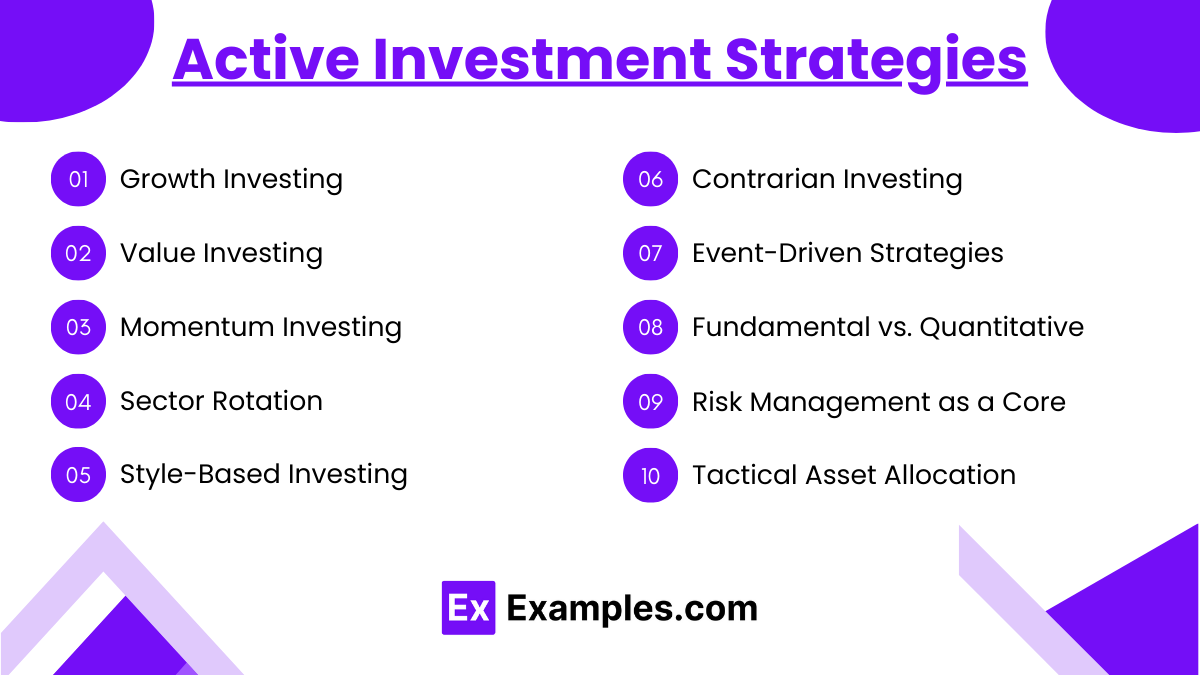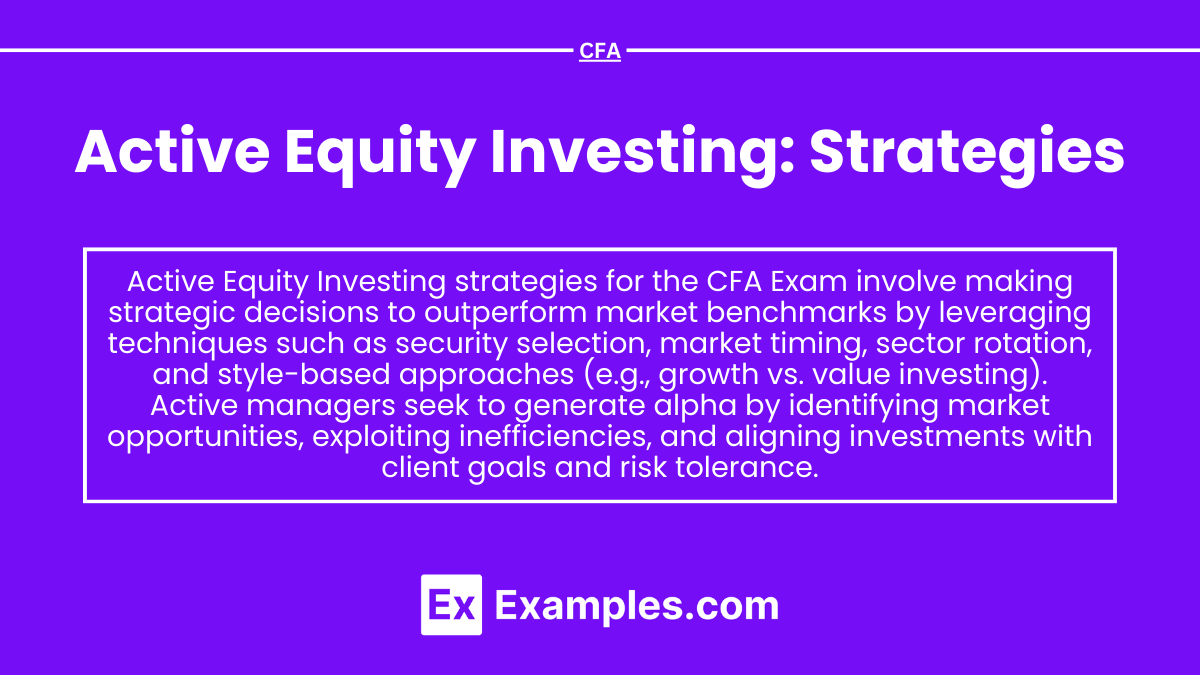Preparing for the CFA Exam requires a comprehensive understanding of Active Equity Investing strategies, a critical component of portfolio management. Mastery of security selection, market timing, and sector rotation is essential. This knowledge helps investors identify market opportunities, achieve alpha, and manage risks, which are crucial for optimizing client portfolios and investment success.
Learning Objective
In studying “Active Equity Investing: Strategies” for the CFA Exam, you should understand methods for generating alpha, including security selection, market timing, and sector rotation. Analyze how active managers use fundamental, technical, and quantitative analysis to identify mispriced assets and capitalize on market inefficiencies. Evaluate strategies like growth vs. value investing, momentum-based approaches, and style-based tilts. Additionally, explore how active equity strategies align with client goals, risk tolerance, and investment constraints, and apply this knowledge to optimizing portfolio performance, adhering to investment policy statements, and navigating real-world market conditions in CFA practice scenarios.
Methods for Generating Alpha

Alpha generation is the core goal of active equity investing and refers to the excess returns achieved by a portfolio compared to its benchmark. Active managers seek to generate alpha through a variety of methods aimed at identifying mispriced securities, capitalizing on market trends, and making strategic investment decisions. Here is a detailed explanation of the primary methods for generating alpha:
1. Security Selection:
Security selection involves identifying individual securities that are expected to outperform the market or a specific benchmark. Active managers conduct detailed analysis, using techniques such as:
- Fundamental Analysis: This includes assessing a company’s financial health, examining its earnings, cash flow, growth potential, and competitive positioning within its industry. Managers look for undervalued stocks or those with strong growth prospects that the market has not yet fully recognized.
- Technical Analysis: This approach focuses on analyzing historical price and volume data to predict future price movements. Technical indicators, charts, and patterns are used to identify potential entry and exit points for trades.
- Quantitative Models: Some managers rely on data-driven algorithms and models to identify investment opportunities based on statistical relationships and predictive factors, such as earnings surprises, valuation metrics, or momentum.
2. Market Timing:
Market timing involves making strategic decisions on when to enter or exit specific markets or individual securities. The goal is to capitalize on market trends, cyclical movements, or anticipated changes in macroeconomic factors. Market timing can include:
- Anticipating Market Moves: Predicting broad market upswings or downturns and adjusting the portfolio’s equity exposure accordingly.
- Tactical Asset Allocation: Shifting assets within an asset class or between different asset classes (e.g., equities and fixed income) based on short-term expectations of market movements or changes in economic conditions.
3. Sector Rotation:
Sector rotation is a strategy that involves reallocating investments across different sectors of the economy based on the expected performance of each sector. This approach relies on:
- Economic Cycles and Trends: Recognizing which sectors tend to perform well during different phases of the business cycle. For example, cyclical sectors such as consumer discretionary and industrials may do well during periods of economic expansion, while defensive sectors like healthcare and utilities may outperform during downturns.
- Relative Valuation and Growth Prospects: Moving capital into sectors that are undervalued or expected to experience significant growth due to market trends or economic changes.
- Industry Trends and Innovations: Investing in sectors or industries undergoing technological shifts, regulatory changes, or significant innovation that can drive growth.
4. Style-Based Tilts and Factor Investing:
Active managers may emphasize specific investment styles (e.g., growth, value, large-cap, small-cap) or factors (e.g., momentum, volatility, quality) to enhance alpha generation. This allows them to tailor their strategies to market conditions and client objectives while leveraging particular factors believed to be sources of excess returns.
5. Risk Management as a Component of Alpha Generation:
Active managers not only seek to generate returns but also manage risks to protect their portfolios from adverse movements. By carefully assessing and mitigating risks, managers can enhance risk-adjusted returns, thereby increasing the likelihood of alpha generation.
Analysis Techniques Used by Active Managers

Active managers rely on various analysis techniques to identify investment opportunities, manage risk, and achieve superior returns (alpha) relative to their benchmarks. The primary techniques used in active equity investing include fundamental, technical, and quantitative analysis. Here’s an in-depth look at these techniques:
1. Fundamental Analysis:
Fundamental analysis involves evaluating the intrinsic value of a security by examining factors such as the company’s financials, industry position, and macroeconomic influences. Key components of fundamental analysis include:
- Financial Statement Analysis: Reviewing a company’s balance sheet, income statement, and cash flow statement to assess profitability, liquidity, leverage, and overall financial health.
- Valuation Metrics: Using metrics such as price-to-earnings (P/E) ratios, price-to-book (P/B) ratios, and discounted cash flow (DCF) models to estimate a stock’s fair value. If a stock is trading below its intrinsic value, it may be considered undervalued and a potential buy.
- Industry and Competitive Analysis: Evaluating a company’s competitive positioning within its industry, barriers to entry, market share, and competitive advantages (e.g., brand strength, patents).
- Macroeconomic Factors: Considering broader economic trends, such as interest rates, inflation, GDP growth, and geopolitical factors that may impact a company’s performance.
2. Technical Analysis:
Technical analysis focuses on analyzing past market data, primarily price and volume, to predict future price movements. It is based on the premise that market prices reflect all available information, and patterns tend to repeat over time. Key elements include:
- Chart Patterns: Identifying formations such as head-and-shoulders, double tops/bottoms, triangles, and trend lines that suggest future price movements.
- Technical Indicators: Using indicators such as moving averages, relative strength index (RSI), and Bollinger Bands to generate buy and sell signals.
- Support and Resistance Levels: Identifying key price levels where buying or selling pressure is likely to emerge, providing potential entry or exit points for trades.
3. Quantitative Analysis:
Quantitative analysis uses mathematical and statistical models to analyze data and make investment decisions. This data-driven approach seeks to identify patterns, correlations, and predictive factors that drive stock performance. Key aspects include:
- Factor-Based Models: Evaluating factors such as momentum, value, size, and quality to select securities that are likely to outperform based on historical data.
- Backtesting and Simulation: Testing the performance of investment strategies using historical data to gauge potential returns and risks before implementation.
- Algorithmic and Data-Driven Strategies: Using algorithms to execute trades based on predefined criteria and data analysis, often at high speeds and volumes.
4. Combining Analysis Techniques:
Many active managers combine fundamental, technical, and quantitative approaches to strengthen their investment decision-making. For example:
- Fundamental-Quantitative Hybrid: A manager may use quantitative screening models to identify undervalued stocks and then apply detailed fundamental analysis to refine their selections.
- Technical Confirmation for Fundamentals: A manager may use technical analysis to identify the optimal timing for buying or selling a security that has been selected based on fundamental analysis.
5. Behavioral Analysis:
Some active managers also incorporate behavioral finance principles to exploit market inefficiencies driven by investor psychology, such as herd behavior, overreaction, and cognitive biases.
6. Risk Management Integration:
Analysis techniques often include a risk management component to ensure that investments align with a client’s risk tolerance and overall portfolio strategy. This involves assessing and mitigating factors that could lead to significant losses or underperformance.
Active Investment Strategies

Active investment strategies aim to outperform a specific market benchmark or index by actively making investment decisions based on various analyses, research, and market predictions. Unlike passive strategies that seek to match market returns, active strategies involve continuously monitoring and adjusting the portfolio to capitalize on market opportunities. Here’s a detailed explanation of key active investment strategies used by portfolio managers:
1. Growth Investing:
Growth investing focuses on identifying companies with high potential for earnings growth, revenue expansion, and market share gains. The primary goal is to invest in companies expected to deliver strong future performance, often trading at high price-to-earnings (P/E) ratios due to market optimism about their growth prospects. Growth investors prioritize:
- Earnings Growth Rates: Companies with consistently high growth rates in earnings.
- Innovation and Market Leadership: Firms leading in new technologies, products, or services.
- Future Potential Over Current Value: Growth stocks may appear overvalued based on traditional valuation metrics, but their future potential is deemed worth the premium price.
2. Value Investing:
Value investing seeks to identify undervalued stocks trading below their intrinsic value. Value investors believe that the market sometimes overreacts to bad news or undervalues a company’s potential, creating opportunities to buy stocks at a discount. Key aspects include:
- Low Price-to-Earnings (P/E) Ratios: Stocks with low P/E ratios relative to their peers or historical averages.
- Price-to-Book (P/B) Ratios: Emphasis on stocks trading below their book value.
- Margin of Safety: Buying undervalued stocks provides a margin of safety, reducing the downside risk.
- Catalysts for Revaluation: Value investors look for potential catalysts that may trigger a price increase, such as management changes, new products, or industry trends.
3. Momentum Investing:
Momentum investing involves buying stocks that have shown strong recent performance (price momentum) and selling those that have underperformed. The strategy is based on the belief that stocks with positive momentum are likely to continue performing well in the near term. Momentum investors focus on:
- Price Trends and Volume: Identifying stocks with sustained upward or downward trends and high trading volume.
- Relative Strength: Selecting securities based on their strength relative to their peers in terms of price movement.
- Timing: Momentum strategies often rely on technical analysis and indicators to determine optimal entry and exit points.
4. Sector Rotation:
Sector rotation strategies involve shifting investments across different sectors of the economy based on expected economic cycles and trends. Active managers rotate capital to sectors that are likely to benefit from current or anticipated market conditions. Key factors include:
- Economic Phases: Understanding which sectors perform well during expansionary or recessionary periods.
- Market Trends and Policies: Analyzing industry trends, regulatory changes, and macroeconomic events to anticipate sector performance.
- Tactical Allocation: Adjusting portfolio weightings based on changing sector prospects.
5. Style-Based Investing:
Style-based investing refers to focusing on specific styles, such as:
- Large-Cap vs. Small-Cap Investing: Large-cap stocks are more established, while small-cap stocks may offer higher growth potential but greater volatility.
- Quality Investing: Investing in high-quality companies with strong balance sheets, consistent earnings, and good governance practices.
6. Contrarian Investing:
Contrarian investors go against prevailing market trends, buying assets that are out of favor and selling those that are popular. This strategy is based on the belief that markets overreact, creating opportunities to profit when prices correct.
7. Event-Driven Strategies:
These strategies focus on exploiting mispricings that may arise from corporate events such as mergers, acquisitions, bankruptcies, or restructurings. Examples include merger arbitrage, where investors speculate on the outcome of an announced acquisition.
8. Fundamental vs. Quantitative Approaches:
Some active managers rely primarily on detailed fundamental analysis of individual stocks, while others use quantitative models and data analysis to identify opportunities and guide investment decisions.
9. Risk Management as a Core Component:
Active strategies integrate risk management techniques to control downside risk, manage volatility, and optimize returns. This may involve setting stop-loss limits, diversifying investments, or using derivatives to hedge risk.
10. Tactical Asset Allocation:
Active managers may adjust their asset allocation based on market conditions, aiming to capitalize on short-term opportunities while managing risk exposure.
Aligning Active Strategies with Client Objectives

Aligning active investment strategies with client objectives is a critical step for portfolio managers to ensure that their investment approach meets the unique needs, preferences, and risk tolerances of their clients. Active strategies, which seek to outperform market benchmarks through security selection, market timing, and portfolio adjustments, must be tailored to align with each client’s specific goals and constraints. Here’s how this alignment is achieved:
1. Understanding Client Goals:
The first step is to clearly understand the client’s investment objectives, such as:
- Capital Growth: Clients seeking long-term appreciation may prioritize growth-oriented strategies, focusing on companies with high earnings potential.
- Income Generation: For clients needing regular income, active strategies may involve selecting dividend-paying stocks or income-generating assets.
- Risk Reduction: Some clients may prioritize capital preservation, leading managers to adopt more conservative strategies, such as defensive stock selection or hedging techniques.
2. Assessing Risk Tolerance and Capacity:
Each client has a different level of comfort with risk. Portfolio managers must assess:
- Risk Tolerance: The client’s psychological willingness to endure market fluctuations and potential losses.
- Risk Capacity: The financial ability to take on risk without jeopardizing long-term financial stability. Active strategies must be tailored to reflect this balance. For risk-averse clients, managers may avoid highly volatile stocks or sectors, while more risk-tolerant clients may be suited to aggressive, high-growth strategies.
3. Customizing Strategies to Meet Client Objectives:
Once goals and risk parameters are established, active strategies can be customized to align with client needs:
- Growth vs. Value Investing: Clients with different preferences may have portfolios tailored to growth stocks, value stocks, or a blend, based on their investment horizons and market outlook.
- Sector and Geographic Preferences: Some clients may wish to avoid or focus on certain sectors or regions. Active managers can allocate capital accordingly, reflecting client preferences in sector rotation or international investing.
- Tax Efficiency: For clients with tax considerations, active strategies may incorporate tax-loss harvesting, holding periods, or other approaches to minimize tax liabilities while pursuing returns.
4. Adhering to Investment Policy Statements (IPS):
An Investment Policy Statement (IPS) outlines the client’s investment objectives, risk tolerance, asset allocation guidelines, and any specific restrictions or preferences. Active strategies are developed within this framework to ensure alignment with the client’s stated goals. Adherence to the IPS ensures that investment decisions remain consistent and transparent.
5. Managing Constraints and Preferences:
Clients may have unique constraints, such as ethical considerations (e.g., avoiding investments in certain industries), liquidity needs, or regulatory restrictions. Active managers must integrate these factors into their strategies while striving to generate returns. For example:
- Ethical Investing: Implementing active strategies that align with ESG (Environmental, Social, and Governance) criteria to reflect a client’s ethical priorities.
- Liquidity Requirements: Adjusting the portfolio to ensure sufficient liquidity for clients needing periodic cash flows or flexibility.
6. Active Monitoring and Adjustments:
Active strategies require continuous monitoring to ensure alignment with changing client needs and market conditions. Managers may make adjustments based on:
- Market Developments: Shifting assets or changing holdings to reflect new market opportunities or risks.
- Client Life Events: Adjusting the strategy if a client’s financial situation, risk tolerance, or goals change (e.g., nearing retirement).
- Performance Reviews: Regularly assessing the portfolio’s performance relative to benchmarks and discussing progress with the client.
Examples
Example 1: Growth Investing
An active manager identifies a technology company with a track record of high revenue growth and innovation. The manager buys the stock, anticipating future earnings growth due to strong demand for its products and market expansion. This growth strategy focuses on capturing gains from companies expected to outperform based on earnings potential.
Example 2: Value Investing
An active manager seeks out stocks trading below their intrinsic value based on fundamental analysis. They invest in a manufacturing company with solid financials and strong cash flow but currently undervalued due to temporary market sentiment. The manager believes market mispricing will correct over time, leading to significant returns.
Example 3: Momentum Investing
A manager notices that a particular sector, such as renewable energy, has experienced strong upward price momentum. By investing in stocks within this sector, they aim to benefit from the continued positive trend, expecting strong near-term gains as demand for sustainable energy increases.
Example 4: Sector Rotation
During a period of economic expansion, an active manager shifts their portfolio allocation toward cyclical sectors like industrials and consumer discretionary, which tend to benefit from increased consumer spending. As economic conditions change, they rotate out of cyclical sectors and into more defensive sectors, such as healthcare and utilities, to manage risk.
Example 5: Contrarian Investing
An active manager takes a contrarian approach by investing in a financial services company that has experienced a sharp decline in its stock price due to temporary issues. Believing the market overreacted and the fundamentals remain strong, the manager anticipates a recovery, aiming to capture outsized returns when the market corrects.
Practice Questions
Question 1:
Which of the following best describes a key objective of active equity investing?
A) Replicating market index returns with minimal deviation
B) Reducing investment costs through passive management
C) Generating excess returns (alpha) relative to a benchmark
D) Avoiding all market risk by using fixed-income securities
Answer: C) Generating excess returns (alpha) relative to a benchmark
Explanation:
Active equity investing aims to outperform a market benchmark by making strategic investment decisions, such as security selection, market timing, and sector allocation. The goal is to generate alpha, or returns in excess of the benchmark, unlike passive investing, which seeks to match index returns with minimal deviation.
Question 2:
Which active strategy focuses on identifying stocks that are expected to deliver strong future earnings growth, often at a premium valuation?
A) Value Investing
B) Growth Investing
C) Momentum Investing
D) Sector Rotation
Answer: B) Growth Investing
Explanation:
Growth investing targets companies with high potential for future earnings growth and often trades at higher valuations compared to the broader market. Investors focus on the potential for substantial returns driven by future expansion, unlike value investing, which seeks undervalued stocks.
Question 3:
An active manager shifts investments from consumer discretionary stocks to utility stocks based on anticipated economic downturns. This strategy is known as:
A) Market Timing
B) Value Investing
C) Sector Rotation
D) Contrarian Investing
Answer: C) Sector Rotation
Explanation:
Sector rotation involves shifting investments across different sectors of the economy based on expected changes in economic conditions or market cycles. In this example, the manager reallocates funds to defensive utility stocks, which tend to perform better during economic downturns, from more cyclical consumer discretionary stocks.


